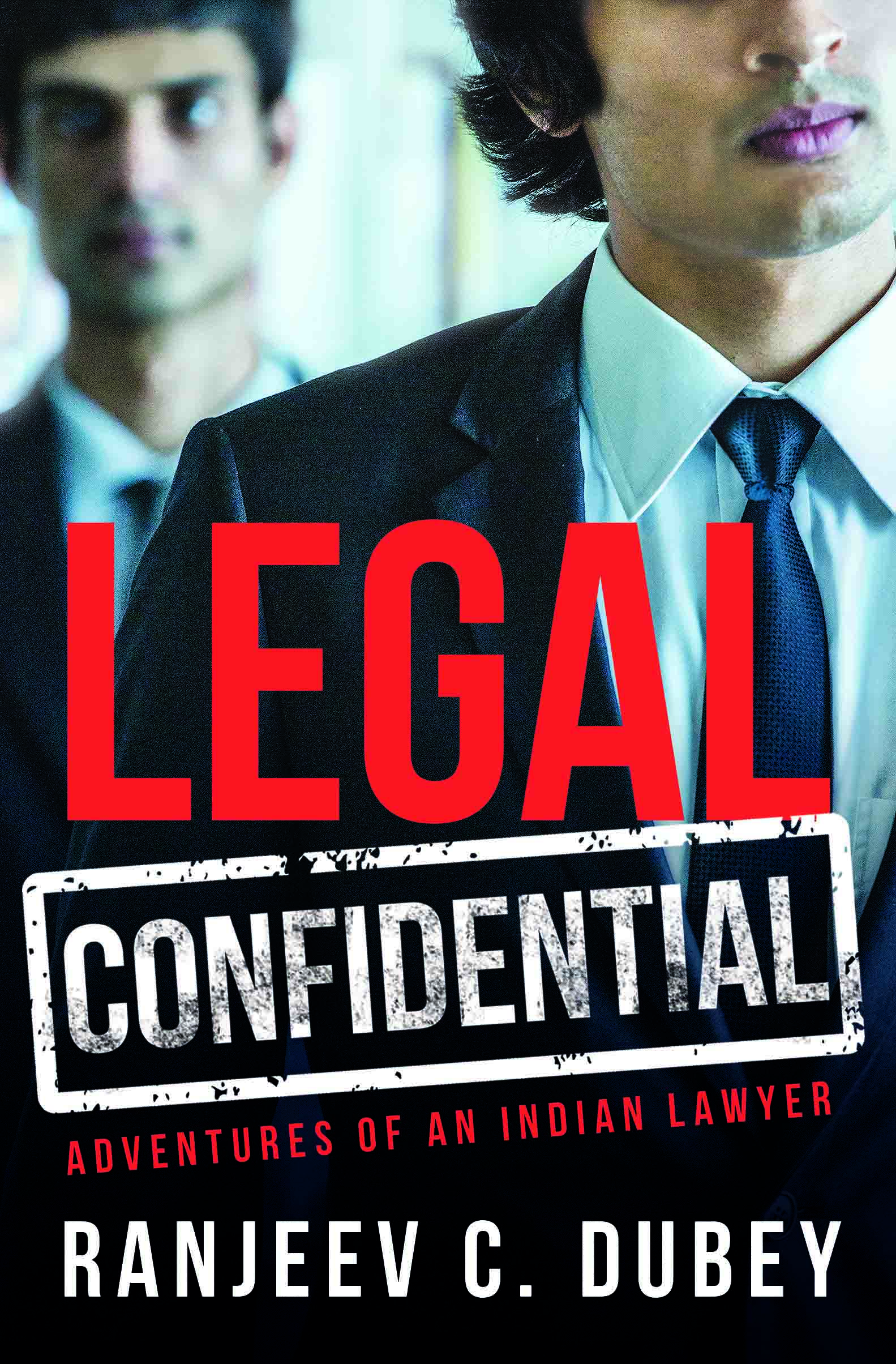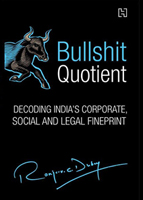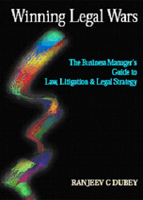Excerpts from Bullshit Quotient:
On the basics of Bullshit and Indian Holy Cows
“Absurdly, in our cultural fabric, spotting the little lie is a skill called wisdom; spotting the big one is a sin called cynicism. Between the two is your average Indian yo-yoing like a soap-opera hero between arranged and love marriage.”
“The bullshit is woven most intimately into the corporate fabric. What is the logic to the stock market where prices vary by the minute? Who really captains the corporate ship? What are the real objectives of a corporation? What is this nexus between politics and industry? As we ponder these questions, we stumble upon a world that has been subject to truly incredible spin.”
On Land Grabs by Corporate Empires
“Indian urban elite, who really are people like us, have long sustained the idea that the short answer to life’s existential questions is ‘development’. We have successfully sold the proposition that development must necessarily be defined as swanky houses, fancy cars, nifty gizmos, high speed highways, glitzy hotels and self-indulgent buffet spreads.”
“Since some poor sod owns this land, we have to wrench it out of his hands. To do so we make a convenient law so that the courts will let us do it. In thus doing we reduce this poor guy to a very poor very desperate jhuggi dweller. If he accepts his fate, we give him a job cleaning our potties and despise him for his backwardness. If he does not accept it and retaliates, we call him a terrorist and slaughter him.”
On Branding Frauds, IPR and Manipulative Marketing
“Of all the bibulous ballyhoo that emerges from the loquacious lips of corporate kookaburras, the weirdest is the idea that the business of a company is delivery of value to its customers.”
“Business is about making money and if you are in business, you are only as good as the money you make. To make money, you have to increase the perceived value of what you sell so that your profit can increase. Perceived value is increased through branding. Branding is the art of making customers want to buy things that are not worth what they are sold.”
“Most nations have created draconian laws to protect the brand rights of companies through Trademarks and other IPR. Most nations have not created any laws to prevent companies from selling products at higher than intrinsic value to their customers.”
On the Healthcare Hoax
“The corporate beast will cut your belly out to increase its IRR. Truly, healthcare has no holy cows.”
“Law generally allows parties to prices everything – an individual’s time, life, body parts, death and even sexual organ use – and then adjudicates and compensates those who have been denied this use. When human life itself is commoditized, what objection can there be to a profit-centric healthcare system?”
“As a society, we are now turning social Darwinists with great commitment. In this society, healthcare companies are running amuck and patients have become revenue-generating lambs for the slaughter”.
On Stock Markets and Small Investors
“Everyone and his pet monkey know that the road to El Dorado goes past the stock-broker’s office. Everyone hopes to invest a crappy buck, have a dream-run and come out a billionaire on the other side of it. All this is hogwash. The stock market is simply a scam waiting to happen.”
“The stock market is not a free trader haven: someone is running it… For you, it is a gamble at best but for the guy who is making the market, you are the sucker who is going to get gang-banged for betting against him”.
On Small Shareholders
“The thing with gambling is that it can wipe you out. The government knows it too, which is why gambling is illegal in much of India. …Yet, this same state is delighted to have you lose your shirt in the stock market. You have to ask yourself if this is because the people who make the market also make the government.”
“Either ways, small shareholders do not know what is going on, have no means to find out what is going on and cannot do anything about it if the wrong things are going on. If that is not perfect powerlessness, what is?”
On Independent Directors
“Independent directors don’t know anything and can’t do anything if they did know something. In truth, independent directors are wall flowers, perching uneasily on tenuous board seats, good to topple any time the promoter chooses. They can’t protect themselves leave alone the small shareholder.”
“Company boards are the corporate equivalent of Hindu eating habits. Eating to the majority of Indians is a very sacred process, replete with dietary restrictions that apply once, twice or every day of the week… Culturally and psychologically, I don’t see us putting together regulation that will make independent directors the force of moral authority and investor protection any time soon.”
On Auditors
“Every spy thriller has its fall-guy and every full contact sport its bum-of-the-month. In the Great Satyam Scam, the fall guy was the auditor. … Out there in the peripheries of reason where there are only TV talk-show hosts trying to shout up ratings, auditors won the victimization game hands down.”
“It is not an auditor’s job to try to accurately report the facts about the company. He does not understand the company or its business, does not understand the environment in which the company operates and does not understand what is going on in it. His job is to look at books and create more papers. Auditing is about reconciling paper trails, not truths! It’s about fighting terrorism by seeing a movie about it.”
“Many accounting frauds are inevitable because Indian businesses make political pay offs which can’t be reflected in the books of accounts. This is what oils our political and bureaucratic machine.”
On Bankers
“Bankers, who we think are quasi-public officers protecting the wider public interest, may well be the first ones to rip off the companies on whose board their nominees sit if they have half a chance of doing it.”
“Bankers don’t get on to boards to protect public shareholders. They get there to sell products, and protect their own money. If they are able to cross sell, they don’t care a swan’s hind what happens to the small shareholder. And if they do get that kind of business, they aren’t going to piss off the promoter and give it all up just to protect someone as marginal as a small shareholder”.
On Confidentiality in India
“The Government of India seems to operate on the basis that evidence of a possible crime entitles it to call a press conference and expose its citizens in all their fallibilities.”
“Indian culture does not give great primacy to the individual, seeing him only as part of a set of social ties and obligations. This culture also requires him to prioritize his social relationships over his confidentiality obligations. But worst of all, the Government of India has no respect for the privacy of the individual, or of the confidentiality of his or her information in their hands. When the king has no regard for the things you value, how would you rate your chances?”
On India’s Buffalo Jurisprudence
“When it comes to legal contracts, we seem to believe that because we wrote something officious and formal, it is something more than the triumph of hope over experience. Not so. When I was a young lawyer in the trial courts back in the 1980s, my first lesson was this pearl from my senior: ‘Contracts are only made to be broken and a broken contract is only a bill to be paid to a lawyer.’
“Everyone and everyone knows that the legal system in India, if system it is, does not work. Sure, if you are very wealthy, very controversial, very political, a celebrity, a victim of a cause dear to the video and print media or the judiciary, or just a really sordid criminal, the system works just fine. But if you are an ordinary Indian with a great deal of moral outrage and not so much money to fund the anger, you are drifting without a paddle on poop creek. You will drift for twenty years or more before someone provides you a half ass solution you are by then too old to digest.
“In this environment, everybody understands that he who wields the stick owns the buffalo. Companies are not the village idiots in our country. …So the next time a company tries to sell you a probity tale, or tells you that if they sign something, they will honour it, do take the time and subject them to a jeering derisive laugh before you spin on the heel of one foot and walk out the door.”
On false Criminal Cases
“In the land of Buddha, a criminal case is nothing but a business tactic taken to the next level, a handcuff is only strategy well played by your enemies and going to jail is only good legal advice you failed to get, or heed.”
On the corporatization of the legal system
“We have seen the political class go from being lionized as liberators from foreign enslavers to being reviled as despicable rogues in two decades. In this time, we have also seen bureaucrats go from being powerful patriarchs to paralyzed possums. We have seen businessmen go from being crooked weasels to admirable entrepreneurs.”
“Of all the platitudes that it is your privilege to dislike, the platitude you could do well to dislike the most is the idea that this country will never change.”
“I recall setting up my independent practice for the price of half a Yezdi motorcycle in 1989; today, you need the price of a Lamborghini Gallardo. As a result, the client–attorney relationship has become depersonalized and transactional.”
On Political Sleaze
“Companies are freebooters engaged in a game of winner-takes- all, or at least as much as they can. The only rules you follow are the rules you can’t afford to ignore. Like freebooters, winning is sometimes impossible without sleaze. At other times, sleaze is the only business!”
“The age of god-men has passed, not least because the age of moral righteousness has passed. We now live in an age where money is sexy and greed is good. … It is not necessary any longer to assume holy garb to play with dirty money.”
“Business continues to be heavily dependent on government. Relations with government depend on one’s ability to find the right fixer mix. … Net, net, sleaze is the grease that lubricates the world of business”.
On Corruption and the Democracy Machine
“Just as one man’s terrorist is another man’s freedom fighter, one man’s bribe is another man’s legitimate revenue stream! Given that the Indian economic system runs on a very uniquely Indian parallel economy, this tendency amongst our urban elite to condemn ourselves without evaluation – to see ourselves as corrupt beyond redemption – is at best a distorted view of the reality. … The other side of the moral rhetoric and the hyperbolic hypocrisy, this parallel economy is the mantra that makes the Indian world – corporate and otherwise – tick over smoothly.”
“The dynamic interplay between companies and politicians benefits both, and is necessary to the continuance of our democracy. Calling such processes scams misses their necessity. … If we want them not to be crooked, we need to create new rules of business and till that day dawns, this crookedness is good for all of us”.
On Complying with the Law
“What makes India extraordinarily interesting is the wide diversity of economic models that coexist in our society. The reality of the life in Gurgaon is not the reality of life in Ballia in east Uttar Pradesh. India has one set of laws, more or less, but there are many India’s, some medieval, some agrarian and rural and a few very globalized and modern. Laws made to service one constituency seem to have no relevance to the concerns of the other.”
“At any given time, there are two laws in operation in India: which one do you comply with? We have a law on the statute book which says don’t corrupt the politician. We also have a law applied on the street which says that if you want a licence, you have to pay the politician. …let’s just say we prefer to comply with the laws on the street rather than the ones on the statute book.”
On the cultural dimension to our contempt for the law
“The good thing about the British Raj was that it gave us British liberal institutions, British law and the English language – stuff that now allows us to try and integrate with the world, perhaps even be amidst the leading runners. The bad thing about the British Raj was that it gave us British liberal institutions, British law and British law written in the English language which allows our elite to nurse a very British contempt of indigenous culture and mind set.”
“We are a society in transition and at some point, the law will come closer to our culture, the culture will come closer to our law and both will come closer to where we need to be in order to bring the greatest good of the greatest number of people. Till that day comes, we can revel in our existential angst and cherry pick from our legal menu.”
“Culturally, India is a multi-tribal society with strong group loyalties which dictates how the individual may behave. Historically, we have had 800 year of colonialism which has created laws that are in conflict with indigenous culture. Politically, we are intensely aware that the war for the control of resources which compels the aggressive pursuit of self-interest. Psychologically, we are constantly conflicted between tribal, cultural and political loyalties all of which are in conflict with our legal regime. As we progress towards a more modern society, we will muddle through these conflicts”.
On the contempt our elites have for India and Indians
“It seems India bashing is like your average airhostess: she can touch you but you can’t touch back!”
“We urban Indian elites are utterly unique in our inexhaustible ability to bitch constantly and about our own society even as we sit at the top of the food chain and exploit it to the hilt.”
On the framework of the Indian mind
“Why should the beggar at the traffic light not grab the gold chain around your neck the first chance he gets? Would it be because Indian policemen carry guns and are crack shots? Is it because our criminal law administration is highly efficient and will inevitably catch him? The fact is that the beggar does not identify your unjust enrichment as the cause of his deprivation.”
“Once we understand the key drives of our life, we see that aspects of our behaviour that we may not approve of have a completely rational basis.”
On India’s future
Change inflicts pain; this is axiomatic. When the Cultural Revolution hit China, millions of ‘intellectuals’ were sent to villages for re-education and slowly starved to death. Parents were paraded in streets in dunce caps, subject to abuse by their own minor children and then ritually slaughtered on the high street in a great spectacle. Monasteries were burnt to the ground, religious institutions were destroyed. We have changed without experiencing significant social cost, without losing our social or family structure and we still have the same political structure as we did in 1947. We have never experienced an economic collapse and we have never had the financial system spontaneously combust as the Russians did after Mikhail Gorbachov. My dad still spends the money he saved in 1947.”
“For a third-rate country of fourth-rate people run badly by a bunch of jokers, we have had a remarkably smooth passage!”
“I can see change everywhere and I ask myself this: Now that Gurgaon’s summer is here, can Jhumri Talaiya’s spring be far behind?”



